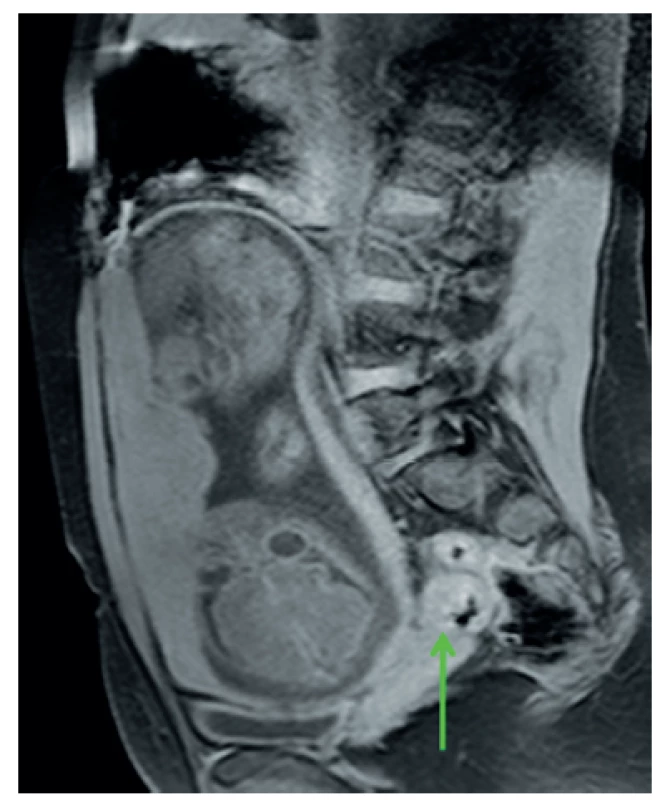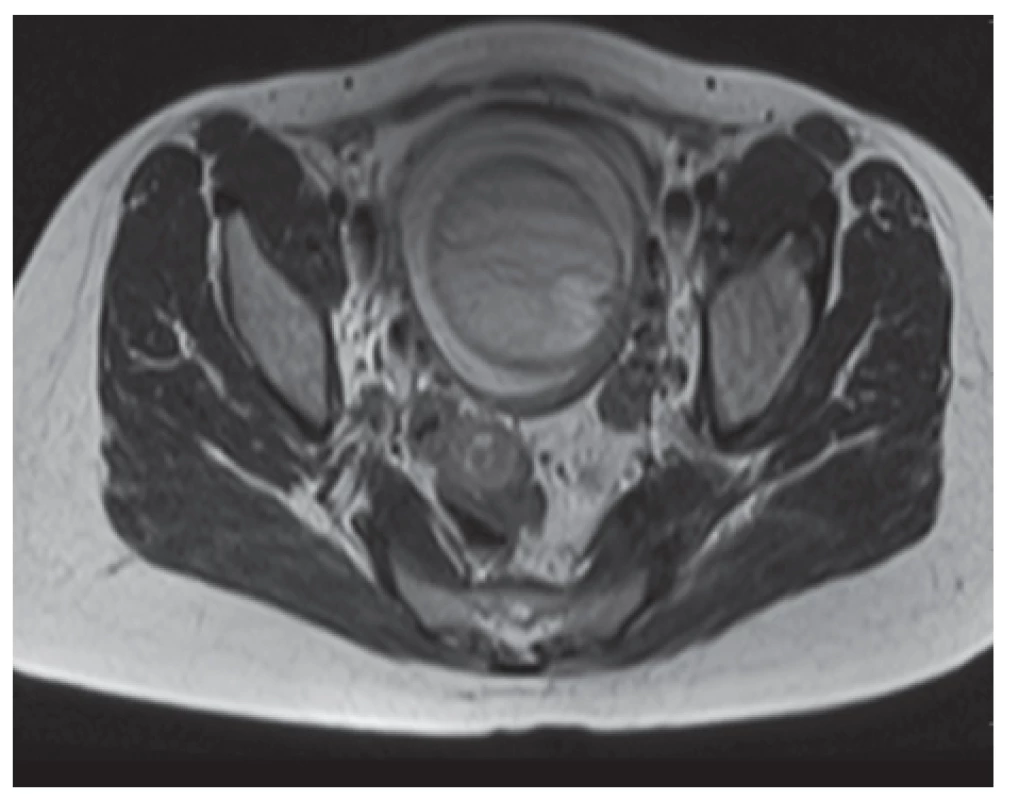Sigmoid colon cancer in pregnancy – a case report
Karcinom sigmoidea v těhotenství – kazuistika
Kolorektální karcinom v těhotenství je vzácné, ale velmi závažné onemocnění. Autoři prezentují kazuistiku pacientky s časným karcinomem sigmoidea v těhotenství a problematiku diskutují ve světle současných literárních poznatků.
Klíčová slova:
kolorektální karcinom – těhotenství – diagnostika – terapie – prognóza
Authors:
P. Kocian 1; J. Hoch 1; M. Halaska 2
Authors place of work:
Department of Surgery, nd Faculty of Medicine, Charles University in Prague and Motol University Hospital, Department Head: prof. J. Hoch, MD, Ph. D.
1; Department of Obstetrics and Gynaecology, 2nd Faculty of Medicine, Charles University in Prague and Motol University Hospital, Department Head: prof. L. Rob, MD, Ph. D.
2
Published in the journal:
Rozhl. Chir., 2015, roč. 94, č. 4, s. 170-173.
Category:
Kazuistika
Summary
Colorectal cancer in pregnancy is a rare but life-threatening disease. The authors present a case of early-stage sigmoid colon cancer in pregnancy, discussing the issue in the light of the current literature.
Key words:
colorectal cancer – pregnancy – diagnosis – treatment – prognosis
INTRODUCTION
Colorectal cancer (CRC) presenting during pregnancy is an uncommon condition that is significantly life-threatening in terms of foetal and maternal health. The cumulative risk of developing CRC in women before their forties is 1 : 2000 [1]. The occurrence of CRC during gestation appears to be 1 in 13,000 pregnancies, with a median patient age of 31. More than 80% of CRCs in pregnant women occur in the rectum. This rectal predominance is the opposite to that found in the general population [2,3].
In this paper, we present a case of a 37-year-old multigravida with early-stage adenocarcinoma of the sigmoid colon diagnosed at 27 weeks of gestation. A healthy female infant was delivered by caesarean section. During this operative procedure, a curative resection of the tumour was performed.
CASE REPORT
A 37-year-old woman (gravida 4, para 2) was referred to our department from a peripheral hospital at 27 weeks gestation with a short history of rectal bleeding. She had no significant medical or surgical history and the course of pregnancy was uneventful. On examination, no cervical dilatation was observed. Obstetric ultrasound found a 27-week-old single live foetus with no foetal abnormalities. No mass was discovered during rectal examination. During colonoscopy performed on the patient, a large polypoid lesion, endoscopically not completely removable, was found in the sigmoid colon. Transanal biopsy of the lesion revealed an adenoma with foci of high-grade dysplasia and early invasive carcinoma (T1 lesion). Abdominal ultrasound showed a normal liver with no metastases. Magnetic resonance imaging (MRI) showed a sigmoid colon tumour invading the pericolic fatty tissue and enlarged mesocolic lymph nodes (Fig. 1, 2). Tumour markers – CEA, CA 19-9 – were not elevated. The patient was discussed in a multidisciplinary medical team and a planned delivery by caesarean section and tumour resection during the same operative procedure was decided upon. Betamethasone was administered to induce foetal lung maturation. Intraoperative assessment of the abdomen confirmed a palpable tumour of the sigmoid colon without lymph node involvement and liver metastases. Both adnexa and the rest of the peritoneal cavity also appeared normal. A 950-gram live female infant with an Apgar score 8-9-9 was delivered at 28 weeks of gestation. After the caesarean procedure, a curative resection of the sigmoid colon tumour with primary anastomosis was performed. Histopathological evaluation of the surgical specimen showed a serrated adenoma with foci of high-grade dysplasia and intramucous carcinoma, grade 1, negative lymph nodes (14/0) and R0 resection. In a detailed postpartum placental examination, no evidence of placental metastasis was found. TNM staging could not be performed due to partial removal of the tumour during endoscopic biopsy. The postoperative course was uneventful. No adjuvant chemotherapy was indicated. At the final available visit of 33 months’ follow-up, the patient was in complete remission and her child was healthy.


DISCUSSION
The most common cancers in pregnancy are those with a peak incidence during the woman’s reproductive period such as cancer of the breast and cervix, melanomas, lymphomas, and leukaemias. CRC presenting during pregnancy is a rare occurrence and is observed in only one in 13,000 pregnancies [2,3]. CRC in young patients is occasionally associated with genetic syndromes or chronic inflammation. Familial adenomatous polyposis, Lynch syndromes, familial colorectal cancer syndrome and long-standing inflammatory bowel disease are present in young patients with CRC more often than in those older than 50 years. In this report, our patient with CRC, however, had sporadic disease with no apparent evidence of having inherited the disorder. There is some controversy in the literature regarding the impact of the hormonal milieu in the pathogenesis and course of CRC. Oestrogens and progestogens that are elevated during pregnancy stimulate cellular proliferation in neoplastic cell cultures in vitro. However, recent experimental data reported a lack of oestrogen /progesterone receptors in CRC [26]. Oestrogens and progestogens do not seem to modify the risk of CRC development, as its incidence is not influenced by the number of gestations or contraceptive use [27].
There are many challenging issues regarding the diagnosis and management of CRC in pregnancy. The initial symptoms of CRC such as abdominal pain, constipation, anaemia and vomiting are usually attributed to pregnancy and rectal bleeding may be misdiagnosed as a sequence of congested haemorrhoids or anal fissure that develop during pregnancy [8]. Therefore, pregnant women are diagnosed with locally advanced or metastatic CRC more often than their non-pregnant counterparts and have a substantially poor prognosis [6]. The most significant complaint that led to an early diagnosis in our patient, in fact, was rectal bleeding. This is why clinicians should be wary of any complaint of the kind mentioned above. The aetiology of every incident of rectal bleeding ought to be uncovered. There are many limitations and contraindications for using diagnostic tools during pregnancy [9,10]. Serum carcinoembryonic antigen (CEA) levels are increased during pregnancy. However, these elevations are within the normal range. Therefore, CEA monitoring may be used in the follow-up of pregnant cancer patients [11,12]. Colonoscopy is the most definite diagnostic modality which provides tumour imaging as well as biopsy of material in patients with colorectal cancer. Colonoscopy in pregnant women carries the risks of uterine pressure, placental abruption, intestinal perforation and foetal injury from maternal hypoxia or diazepam administration. Colonoscopy for left-sided tumours is generally safe and should be considered routine in pregnant women [13]. In a case of colonoscopy for right-sided tumours, avoidance of increased abdominal pressure, positioning in a left lateral decubitus position to avoid the supine hypotensive syndrome, gentleness of manipulations, administration of nasal oxygen to the mother and cardiotocography monitoring are necessary to minimize associated risks [14]. Abdominal ultrasound is a safe method for the foetus which can detect liver metastases larger than 1 cm with sensitivity of 75% [14]. Computed tomography (CT) is the standard imaging technique used for determining the locoregional and distant disease in CRC. However, plain abdominopelvic radiographs and CT are not recommended during pregnancy due to their teratogenic and carcinogenic effects on the foetus [10,15,16]. As in the presented case, MRI is preferred to CT for cancer staging in pregnancy. MRI seems to be safe in pregnancy; however, the safety of contrast agents used with this imaging has not been approved for the foetus. Many authors advise avoiding contrast-enhanced MRI during the first trimester of pregnancy, a period crucial for organogenesis [17,18].
Although treatment of CRC is the same in pregnancy as well as in other situations, the presence of the foetus in pregnancy, of course, presents certain aspects to consider. The timing and type of surgery depends on the gestational stage, elective or emergency presentation, the extent of disease, prognosis and wishes of the patient. Generally, in the first 20 weeks of gestation, surgical resection is indicated to minimize the risk of disease progression. In most instances, such an operation should be possible without interrupting the pregnancy. The rate of embryonic mortality is reported to be 3.8%, with the incidence of premature delivery and low birth weight double that of the general population [19]. In the second 20 weeks of gestation, the operation is delayed until a viable foetus can be delivered. A vaginal delivery is preferred by some authors, with caesarean section reserved for those patients with tumours that obstruct the birth canal or require caesarean section for obstetric reasons independent of the colorectal tumour. Other authors recommend caesarean section for all deliveries in order to avoid high pressure and trauma to the tumour during the delivery. If delivery is vaginal, resection of the tumour is carried out after the involution of the uterus and resolution of vascular congestion of pelvic structures, usually 1–2 weeks after delivery [20]. If caesarean section is performed, tumour resection may take place during the same operative procedure [21]. In this report, our patient had an early-stage adenocarcinoma of sigmoid colon diagnosed at 27 weeks of gestation. Because of suspected lymphatic involvement at MRI and the risk of locoregional tumour progression, a multidisciplinary medical board resulted in the decision to induce foetal lung maturation, after which a caesarean section and tumour resection at the same time took place (at 28 weeks of gestation). Some controversy exists regarding the surgical management of the ovaries. The incidence of ovarian deposits in patients with CRC in the general population is 3–8%. However, in women younger than 40 years with CRC, the incidence of ovarian metastases increases to 25% [22,23]. In view of the relatively high frequency of ovarian deposits, some authors recommend visual inspection and biopsy of the ovaries during a cancer operation. If the uterus is to be left and the ovaries look normal, as in the presented case, ovarectomy should not be performed [21]. Metastases to the placenta or embryo are extremely rare (one reported case only). Despite that, complete evaluation of the placenta and follow-up of the child with periodic ultrasound, CEA and CA 19-9 is proposed in the literature [24]. An emergency laparotomy may be necessary upon occurrence of acute intestinal bleeding, perforation or obstruction for resection of tumour and management of the acute complication. This should take place immediately at any gestational stage [14]. Most cases (about 80%) of CRC in pregnancy tend to involve the rectum and mainly present at stage III [3]. Therefore, a large portion of these patients needs to receive neoadjuvant therapy before rectal surgical resection. Pelvic radiotherapy in pregnancy to a cumulative dose of 40–45 Gy is associated with embryonic or foetal death, malformation, and growth retardation [25]. Any pregnant patient with rectal cancer requiring pelvic radiotherapy, before or after surgery, should either discontinue pregnancy or defer radiotherapy until after delivery. Administration of 5-fluorouracil-based chemotherapy is relatively safe during the second and third trimester of pregnancy, as stillbirth or congenital defects are seldom seen (2–3% of pregnancies). By contrast, foetal exposure to cytotoxic agents during the first trimester, a period crucial for organogenesis, carries a high risk of congenital malformations and abortion (15–25%) [14]. More detailed information on multimodal therapy in the treatment of rectal cancer in pregnancy is beyond the scope of this article.
The prognosis of CRC is the same at each stage for both pregnant and non-pregnant patients. Unfortunately, as already mentioned, gravid women are more often diagnosed with more advanced disease [3,5,6]. In the present report, a prompt diagnostic evaluation of rectal bleeding led, in our patient, to the detection of early-stage sigmoid colon cancer and its curative resection. Clinicians caring for pregnant women should be wary of any complaints of the kind mentioned above and suspected patients investigated thoroughly.
CONCLUSION
CRC in pregnancy is a rare disease but one that may be life-threatening. Prognosis is usually poor due to delay in the diagnosis, as early symptoms are confused with symptoms common in pregnancy. The key to improved survival is early diagnosis and treatment, which demands a high suspicion for this disease among clinicians caring for gravid women. The pregnant woman should actively participate in the decision-making process.
Abbreviations
CA 19-9 – carbohydrate antigen 19-9, also called cancer antigen 19-9
CEA – carcinoembryonic antigen
CRC – colorectal cancer
CT – computed tomography
MRI – magnetic resonance imaging
TNM – tumour, node, metastasis
Conflict of Interests
The authors declare that they have not conflict of interest in connection with the emergence of and that the article was not published in any other journal.
Petr Kocian, MD, Ph.D.
Department of Surgery, 2nd Faculty of Medicine,
Charles University in Prague and Motol University Hospital
V Uvalu 84
150 06 Prague 5
email:petr.kocian@fnmotol.cz
Zdroje
1. Jemal A, Thomas A, Murray T, et al. Cancer statistics, 2002. CA Cancer J Clin 2002;52 : 23−47.
2. Rokyta Z, Šubrtová J. Prekancerózy a zhoubné nádory v těhotenství. Postgraduální medicína 2001;6 : 668−74.
3. Bernstein MA, Madoff RD, Caushaj PF. Colon and rectal cancer in pregnancy. Dis Colon Rectum 1993;36 : 172−8.
4. Morice P, Uzan C, Uzan S. Cancer in pregnancy: a challenging conflict of interest. Lancet 2012;379 : 495−6.
5. Woods JB, Martin JN Jr, Ingram FH, et al. Pregnancy complicated by carcinoma of the colon above the rectum. Am J Perinatol 1992;9 : 102−10.
6. Shushan A, Stemmer SM, Reubinoff BE, et al. Carcinoma of the colon during pregnancy. Obstet Gynecol Surv 1992;47 : 222−5.
7. Vitoratos N, Salamalekis E, Makrakis E, et al. Sigmoid colon cancer during pregnancy. Eur J Obstet Gynecol Reprod Biol 2002;104 : 70−2.
8. Khodaverdi S, Valeshabad KA, Khodaverdi M. A case of colorectal cancer during pregnancy: A brief review of the literature. Case Rep Obstet Gynecol 2013; ID 626393, 4 pages.
9. Peccatori FA, Azim HA Jr, Orecchia R, et al. Cancer, pregnancy and fertility: ESMO Clinical Practice Guidelines for diagnosis, treatment and follow-up. Ann Oncol 2013;24,Suppl 6 : 160−70.
10. Baysinger CL. Imaging during pregnancy. Anesth Analg 2010;110 : 863−7.
11. Ercan Ş, Kaymaz Ö, Yücel N, et al. Serum concentrations of CA 125, CA 15-3, CA 19-9 and CEA in normal pregnancy: a longitudinal study. Arch Gynecol Obstet 2012;285 : 579−84.
12. Lamerz R, Ruider H. Significance of CEA determinations in patients with cancer of the colon-rectum and the mammary gland in comparison to physiological states in connection with pregnancy. Bull Cancer 1976;63 : 575−86.
13. Cappell MS, Colon VJ, Sidhom OA. A study at 10 medical centers of the safety and efficacy of 48 flexible sigmoidoscopies and 8 colonoscopies during pregnancy with follow-up of fetal outcome and with comparison to control groups. Dig Dis Sci 1996;41 : 2353−61.
14. Pentheroudakis G. Gastrointestinal, urologic and lung malignancies during pregnancy. In: Surbone A, Pecccatori F, Pavlidis N, et al. Cancer and pregnancy. Berlin, Springer-Verlag, Berlin Heildeberg 2008;137−64.
15. Brent RL. Radiation teratogenesis. Teratology 1980;21 : 281−98.
16. Hodnett PA, Maher MM. Imaging of gastrointestinal and hepatic diseases during pregnancy. Best Pract Res Clin Gastroenterol 2007;21 : 901−17.
17. Kanal E. Pregnancy and the safety of magnetic resonance imaging. Magn Reson Imaging Clin N Am 1994;2 : 309−17.
18. Strašilová P, Procházka M, Pilka R. Maligní tumory v těhotenství. Postgraduální medicína 2014;5 : 52−61.
19. Nesbitt JC, Moise KJ, Sawyers JL. Colorectal carcinoma in pregnancy. Arch Surg 1985;120 : 636−40.
20. Walsh C, Fazio VW. Cancer of the colon, rectum, and anus during pregnancy. The surgeon’s perspective. Gastroenterol Clin North Am 1998;27 : 257−67.
21. Recalde M, Holyoke ED, Elias EG. Carcinoma of the colon, rectum, and anal canal in young patients. Surg Gynecol Obstet 1974;139 : 909−13.
22. Pitluk H, Poticha SM. Carcinoma of the colon and rectum in patients less than 40 years of age. Surg Gynecol Obstet 1983;157 : 335−7.
23. Kitoh T, Nishimura S, Fukuda S, et al. The incidence of colorectal cancer during pregnancy in Japan: report of two cases and review of Japanese cases. Am J Perinatol 1998;15 : 165−71.
24. Martin DD. Review of radiation therapy in the pregnant cancer patient. Clin Obstet Gynecol 2011;54 : 591−601.
25. Slattery ML, Samowitz WS, Holden JA. Estrogen and progesterone receptors in colon tumors. AM J ClinPathol 2000;113 : 364−8.
26. Chute CG, Willett WC, Colditz GA, et al. A prospective study of reproductive history and exogenous estrogens on the risk of colorectal cancer in women. Epidemiology 1991;2 : 201−7.
Štítky
Chirurgie všeobecná Ortopedie Urgentní medicínaČlánek vyšel v časopise
Rozhledy v chirurgii

2015 Číslo 4
- Metamizol jako analgetikum první volby: kdy, pro koho, jak a proč?
- Stillova choroba: vzácné a závažné systémové onemocnění
- Perorální antivirotika jako vysoce efektivní nástroj prevence hospitalizací kvůli COVID-19 − otázky a odpovědi pro praxi
- S MUDr. Kamilou Kotíkovou o novém pilíři včasné diagnostiky osteoporózy − denzitometrii v gynekologické praxi
Nejčtenější v tomto čísle
- The ONSTEP inguinal hernia repair technique
- Massive small intestine bleeding: CT-angiography and surgical treatment – a case report
- The past and present of thumb reconstruction
- Acute necrotizing pancreatitis: traditional laparotomy vs. minimally invasive procedures

